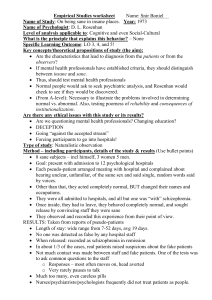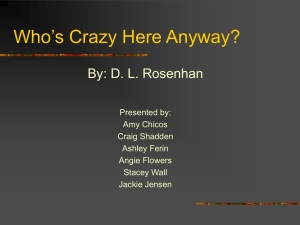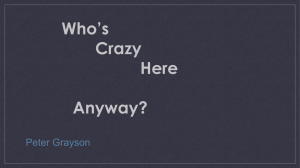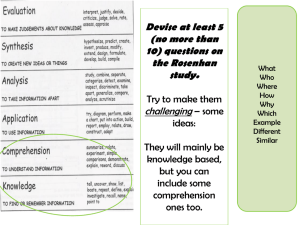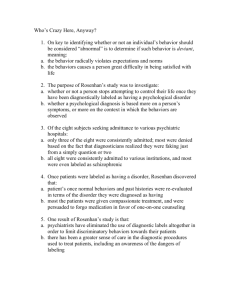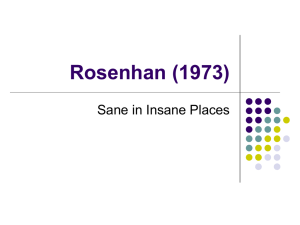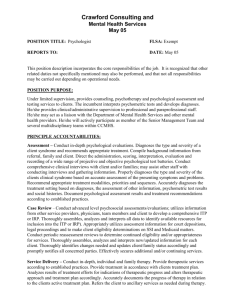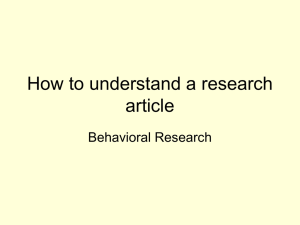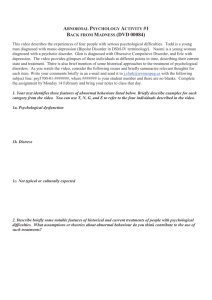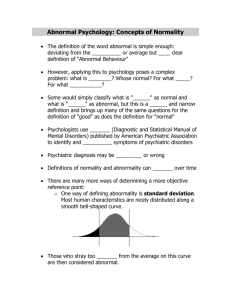Summary/Analysis Page for 40 Studies that Changed Psychology
advertisement
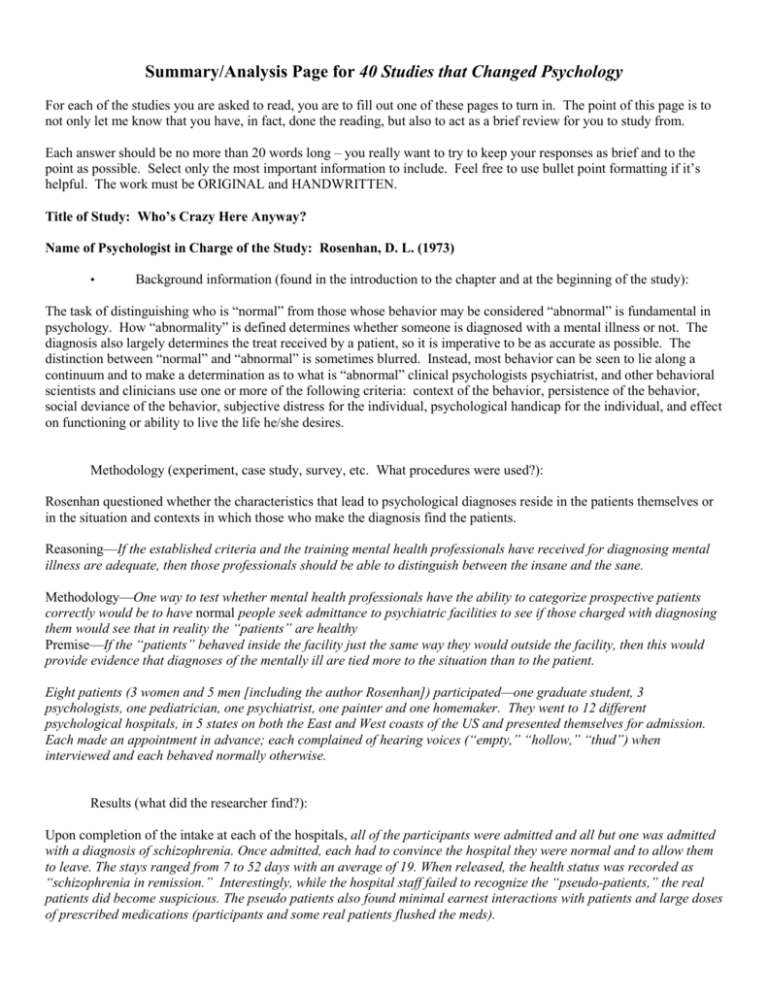
Summary/Analysis Page for 40 Studies that Changed Psychology For each of the studies you are asked to read, you are to fill out one of these pages to turn in. The point of this page is to not only let me know that you have, in fact, done the reading, but also to act as a brief review for you to study from. Each answer should be no more than 20 words long – you really want to try to keep your responses as brief and to the point as possible. Select only the most important information to include. Feel free to use bullet point formatting if it’s helpful. The work must be ORIGINAL and HANDWRITTEN. Title of Study: Who’s Crazy Here Anyway? Name of Psychologist in Charge of the Study: Rosenhan, D. L. (1973) • Background information (found in the introduction to the chapter and at the beginning of the study): The task of distinguishing who is “normal” from those whose behavior may be considered “abnormal” is fundamental in psychology. How “abnormality” is defined determines whether someone is diagnosed with a mental illness or not. The diagnosis also largely determines the treat received by a patient, so it is imperative to be as accurate as possible. The distinction between “normal” and “abnormal” is sometimes blurred. Instead, most behavior can be seen to lie along a continuum and to make a determination as to what is “abnormal” clinical psychologists psychiatrist, and other behavioral scientists and clinicians use one or more of the following criteria: context of the behavior, persistence of the behavior, social deviance of the behavior, subjective distress for the individual, psychological handicap for the individual, and effect on functioning or ability to live the life he/she desires. Methodology (experiment, case study, survey, etc. What procedures were used?): Rosenhan questioned whether the characteristics that lead to psychological diagnoses reside in the patients themselves or in the situation and contexts in which those who make the diagnosis find the patients. Reasoning—If the established criteria and the training mental health professionals have received for diagnosing mental illness are adequate, then those professionals should be able to distinguish between the insane and the sane. Methodology—One way to test whether mental health professionals have the ability to categorize prospective patients correctly would be to have normal people seek admittance to psychiatric facilities to see if those charged with diagnosing them would see that in reality the “patients” are healthy Premise—If the “patients” behaved inside the facility just the same way they would outside the facility, then this would provide evidence that diagnoses of the mentally ill are tied more to the situation than to the patient. Eight patients (3 women and 5 men [including the author Rosenhan]) participated—one graduate student, 3 psychologists, one pediatrician, one psychiatrist, one painter and one homemaker. They went to 12 different psychological hospitals, in 5 states on both the East and West coasts of the US and presented themselves for admission. Each made an appointment in advance; each complained of hearing voices (“empty,” “hollow,” “thud”) when interviewed and each behaved normally otherwise. Results (what did the researcher find?): Upon completion of the intake at each of the hospitals, all of the participants were admitted and all but one was admitted with a diagnosis of schizophrenia. Once admitted, each had to convince the hospital they were normal and to allow them to leave. The stays ranged from 7 to 52 days with an average of 19. When released, the health status was recorded as “schizophrenia in remission.” Interestingly, while the hospital staff failed to recognize the “pseudo-patients,” the real patients did become suspicious. The pseudo patients also found minimal earnest interactions with patients and large doses of prescribed medications (participants and some real patients flushed the meds). Discussion (what do these results mean?): (1) Even trained professionals cannot distinguish the “normal” from the “abnormal” (2) The setting, particularly hospitals, influence the perspective—“if they are here, they must be crazy” mindset. (3) Hospital staff ignored the impact of situational factors on patients and regarded all behavior as relevant to the pathology assigned to the patient Critique (strengths and weaknesses of study): Critics report Rosenhan did not prove the procedures for evaluating patients are inaccurate. Also, it is common to have “symptom variation” among patients with psychological disorders, so staff who continued to regard the pseudo-patients as abnormal were not incompetent. Relevance/Recent Applications: Sensitivity about assigning labels and diagnoses to people; When applied, labels are done with care and respect for the powerful impact labels can have; focus on treatments that do not involve medications or hospitalizations (where possible); controversy over the validity of psychological diagnoses continues today (for example, inventing symptoms for a host of social, legal reasons) is a concern—“get out of jail free card,” access to prescription drugs, etc.). Ethical issues (discuss any issues that might have been involved or that were avoided): Apart from embarrassment for hospital personnel, no ethical considerations noted. Study actually advocates for greater focus on mental illness and tolerance of affected individuals. Relevant gender/cross-cultural differences/issues (were gender/cross-cultural issues or differences addressed? Should they be?): YOUR TURN, CLASS (HW) How does this study relate to the chapter we’re covering in class, or even previous chapters? Use appropriate terminology when relevant: YOUR TURN, CLASS (HW) Personal Discussion/Connection (write about your questions, anything interesting you learned, issues the reading make you think of, such as connections with your life, current events, etc.)(This answer can be longer than 20 words): YOUR TURN, CLASS (HW) Mnemonic device/cartoon to help you remember the researcher/topic of study: Plus video “On Being Sane in Insane Places” Rosenhan And I’m not talking about the patients!!!
